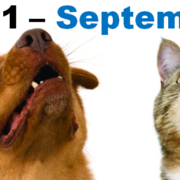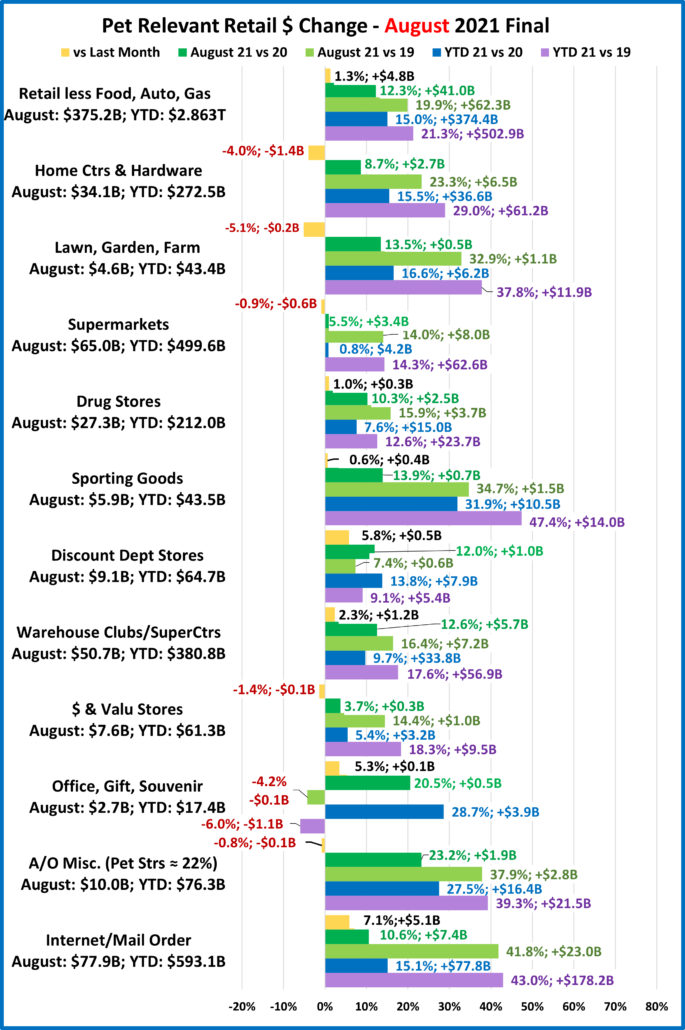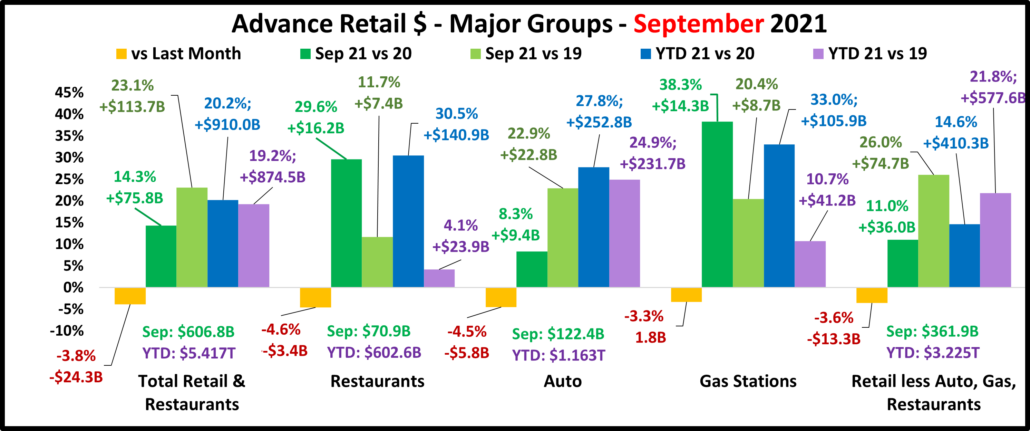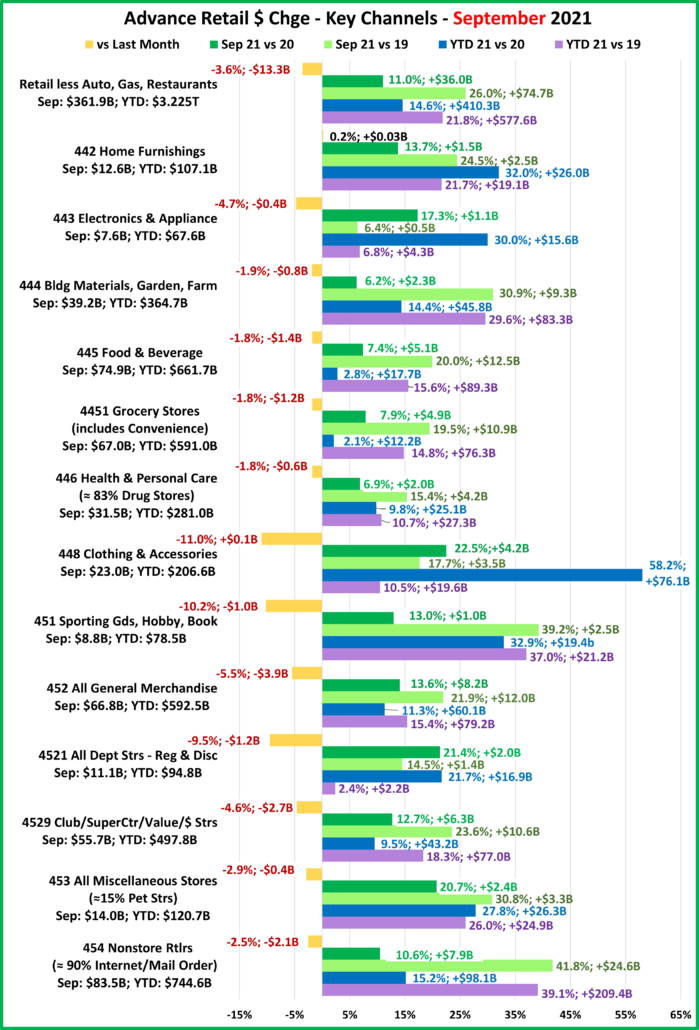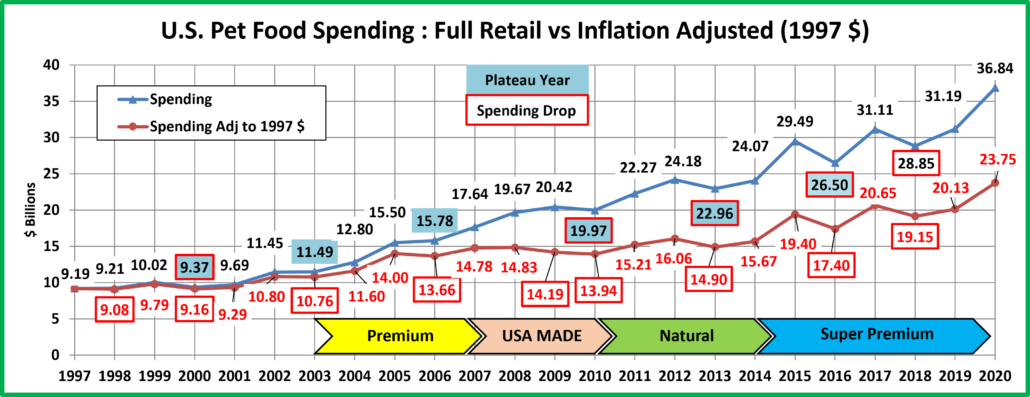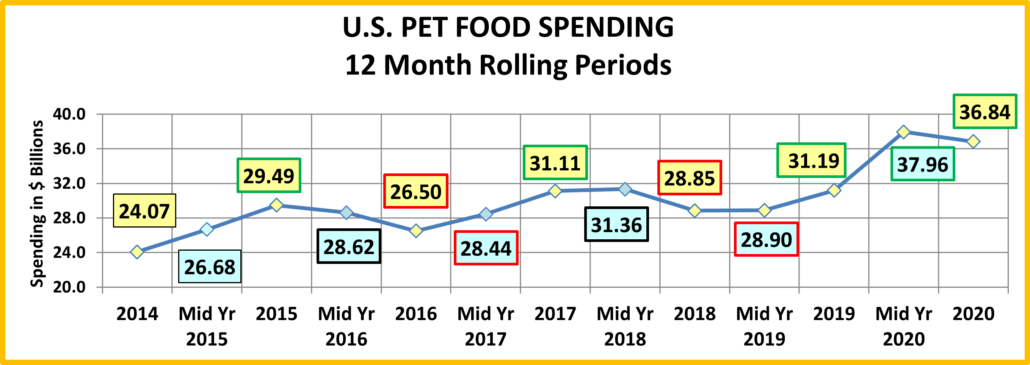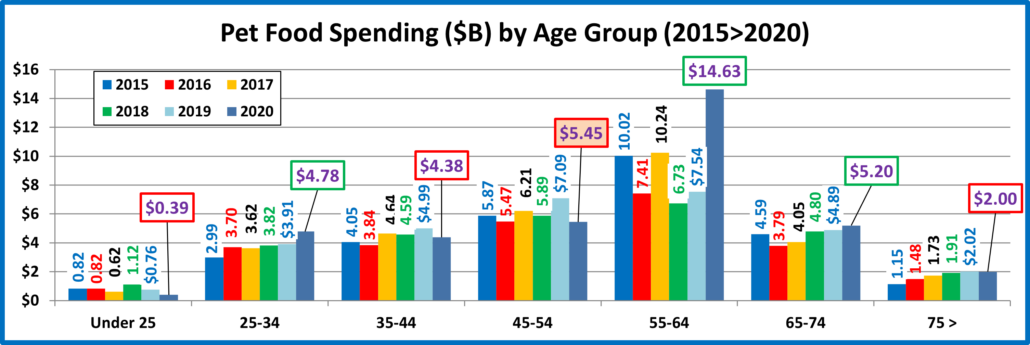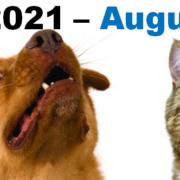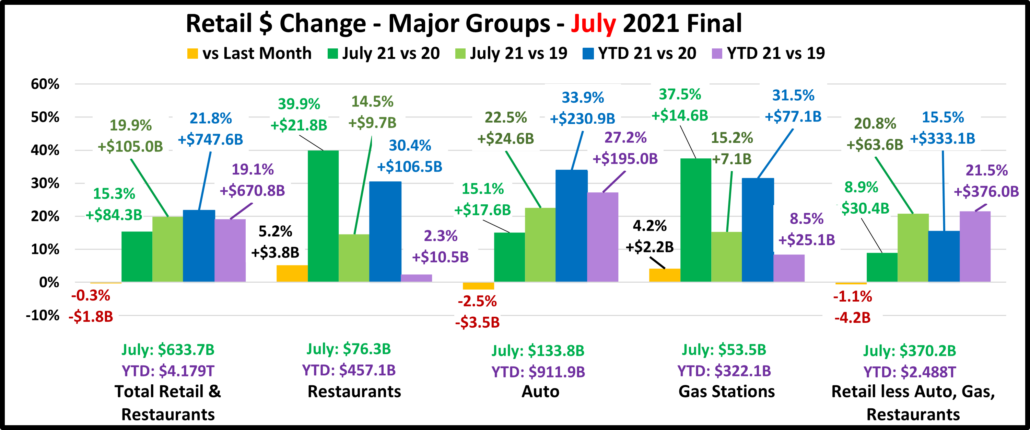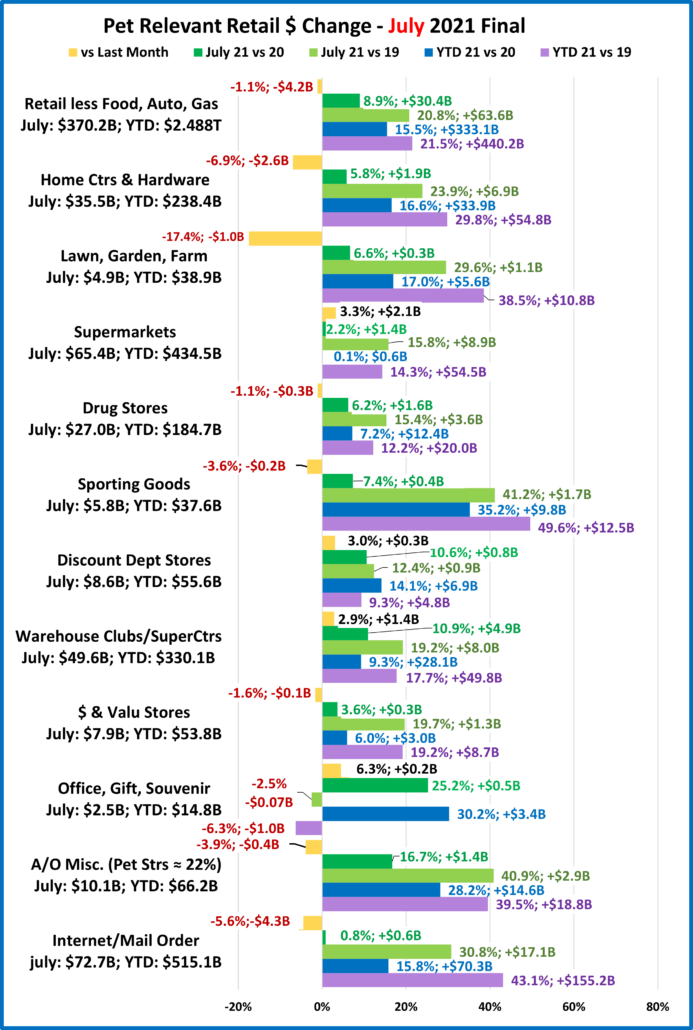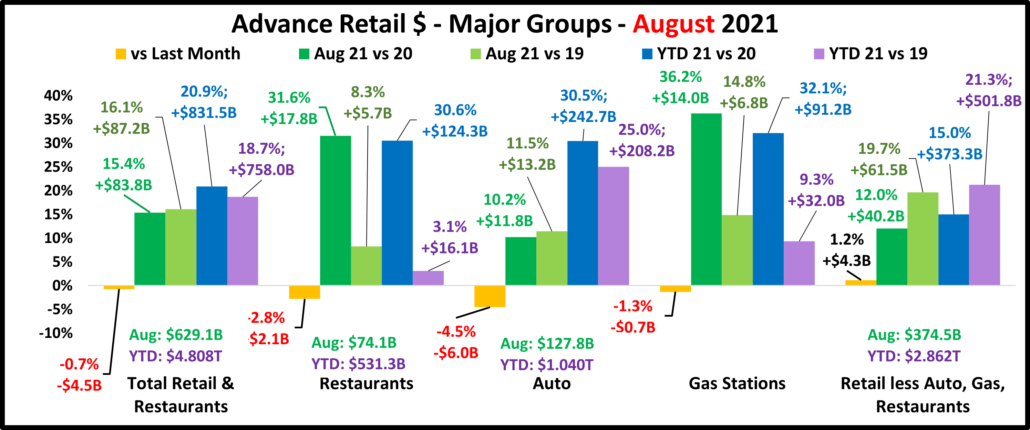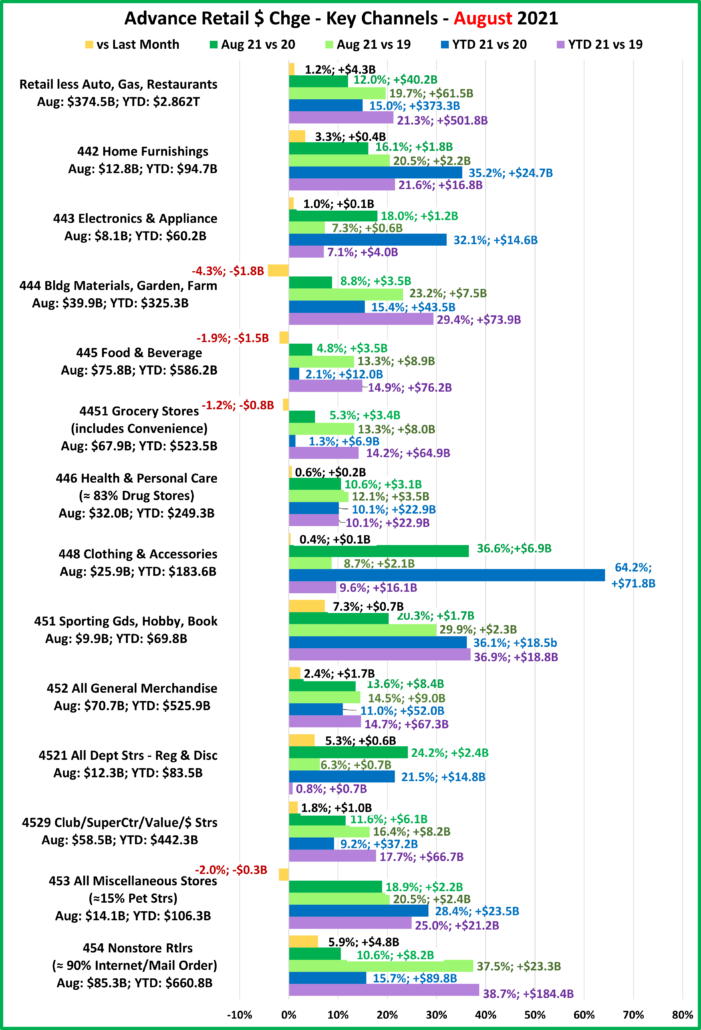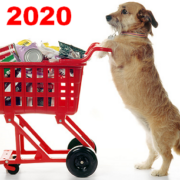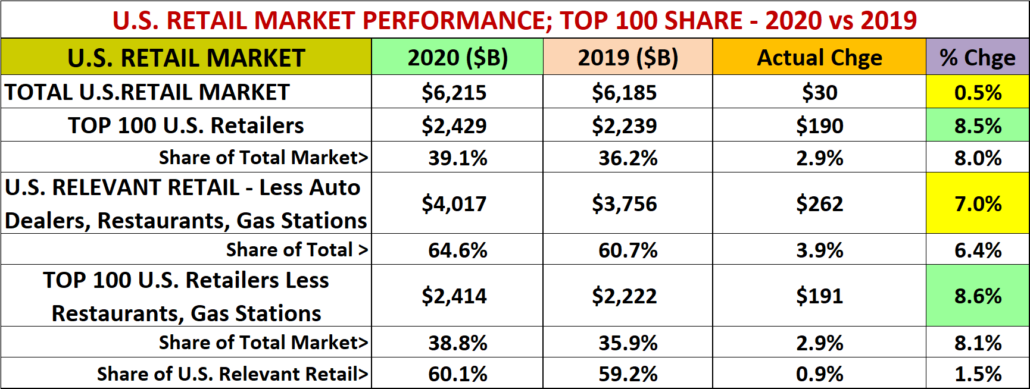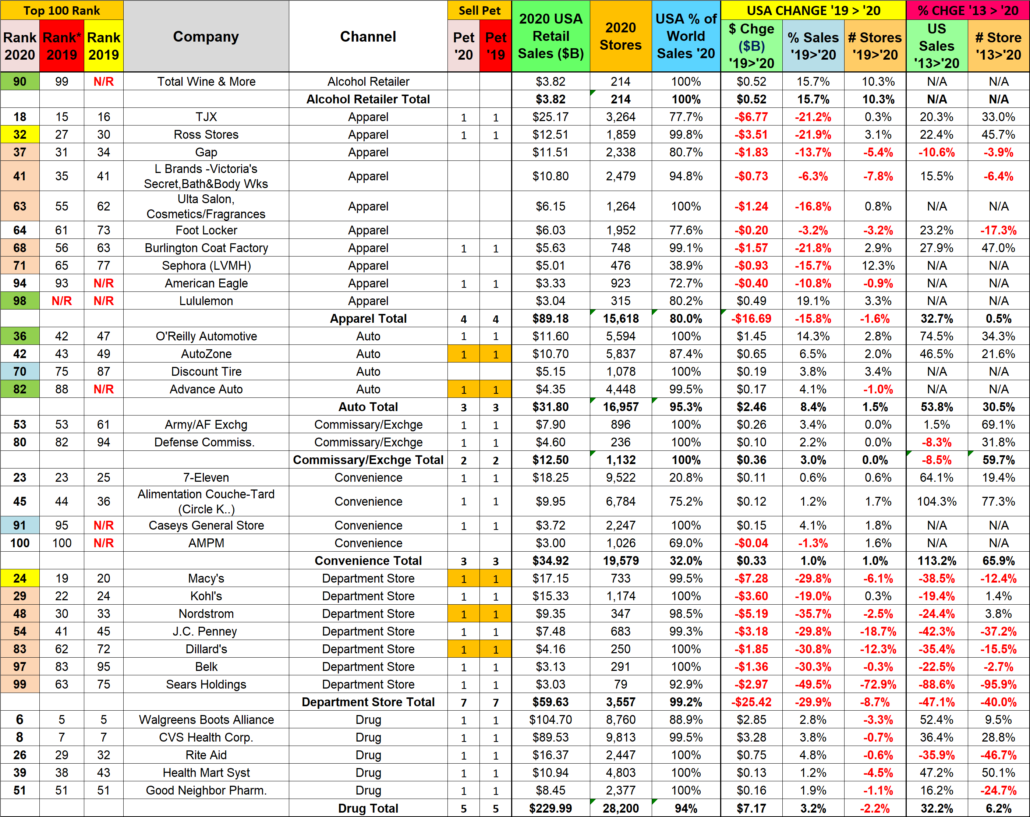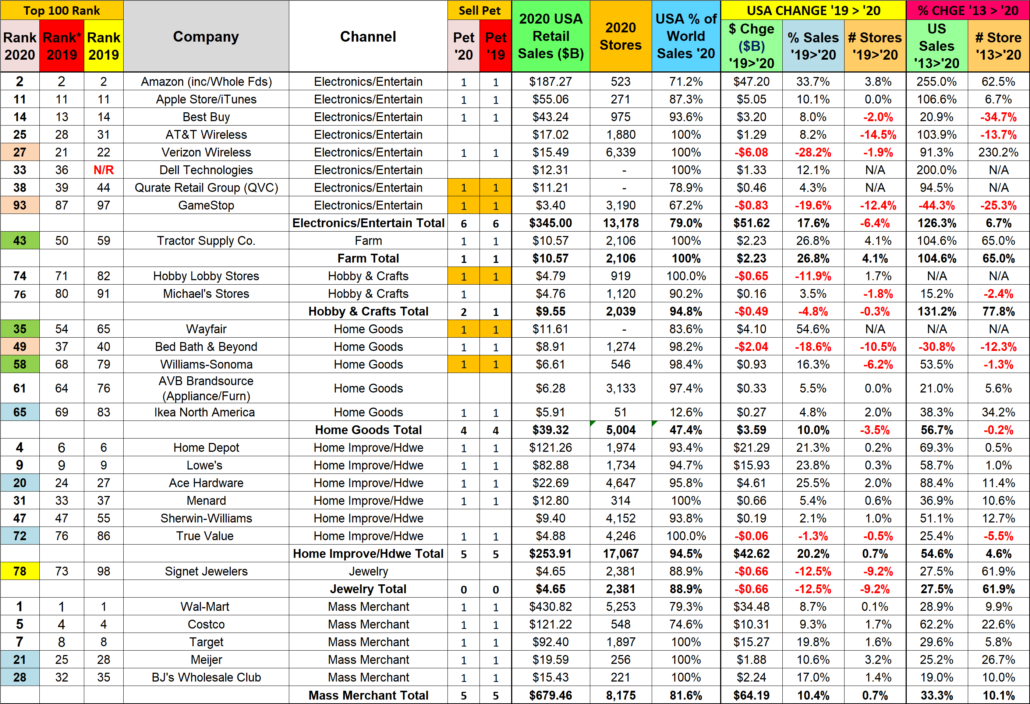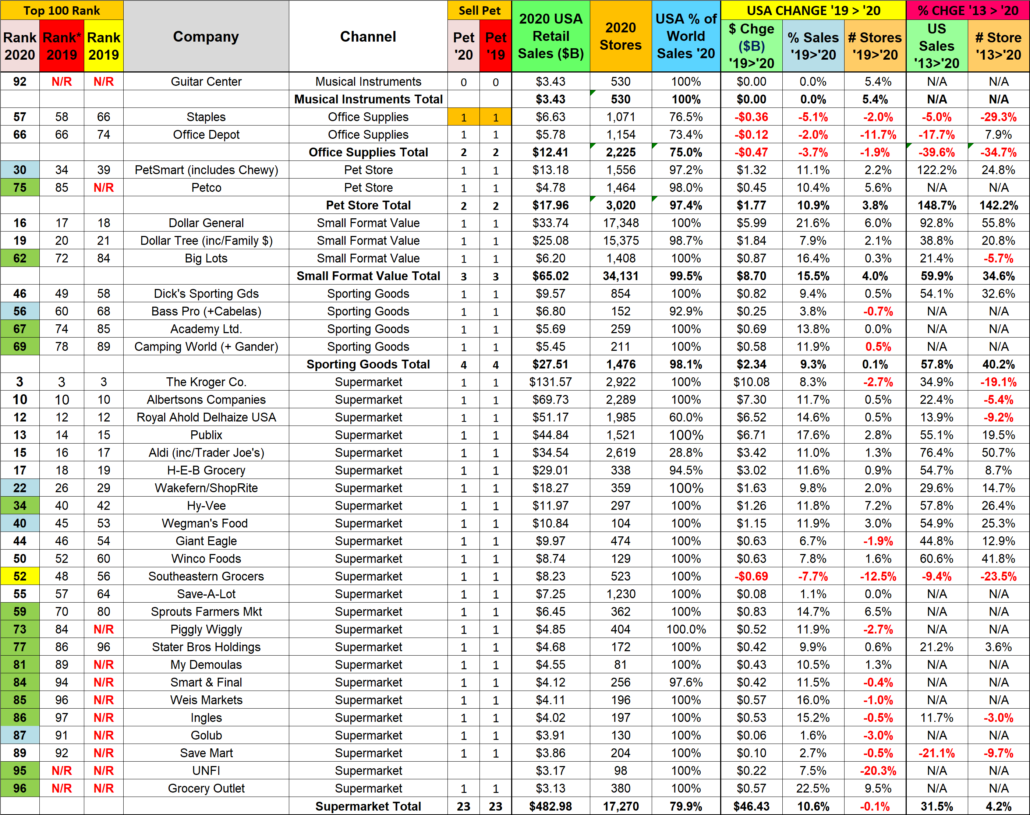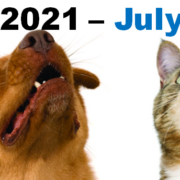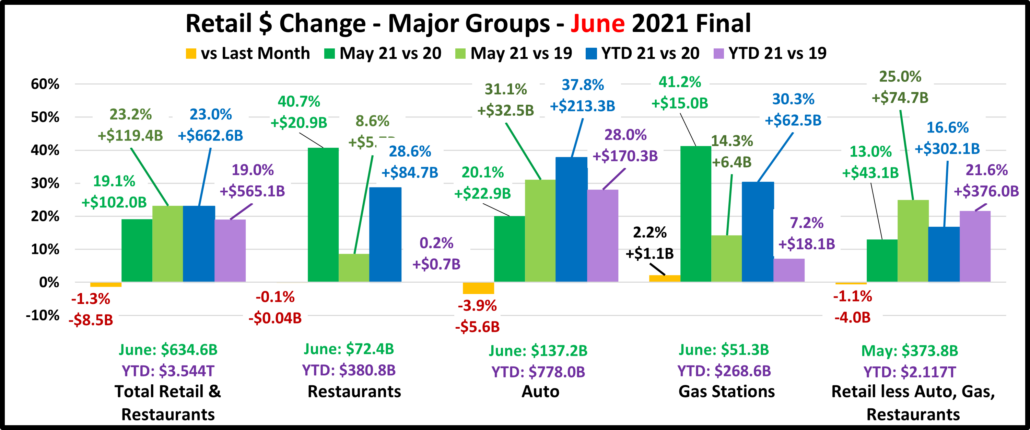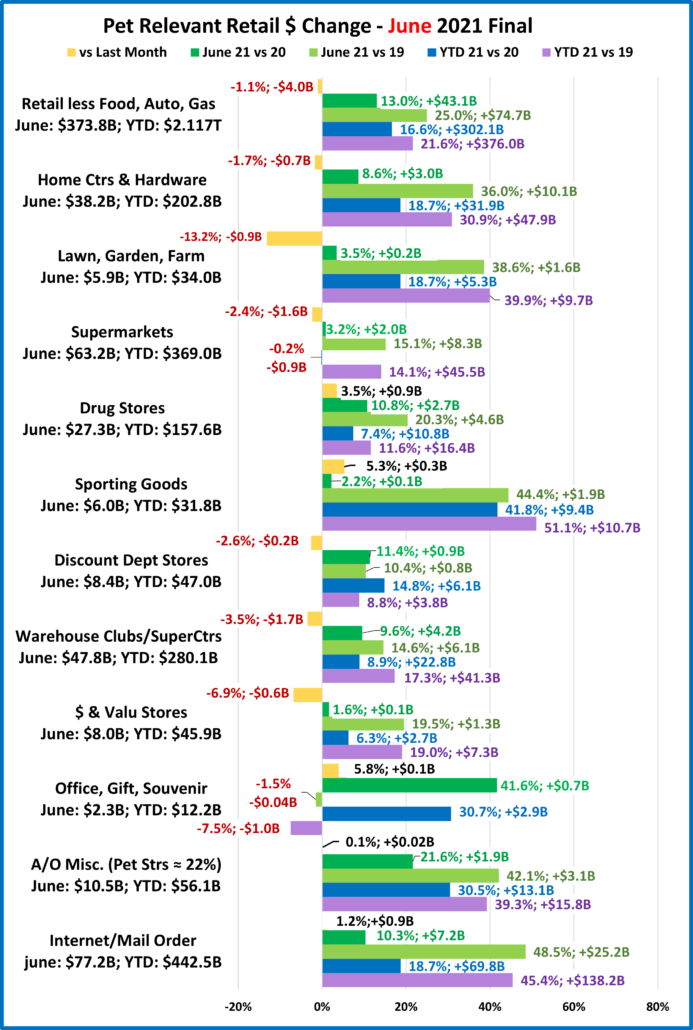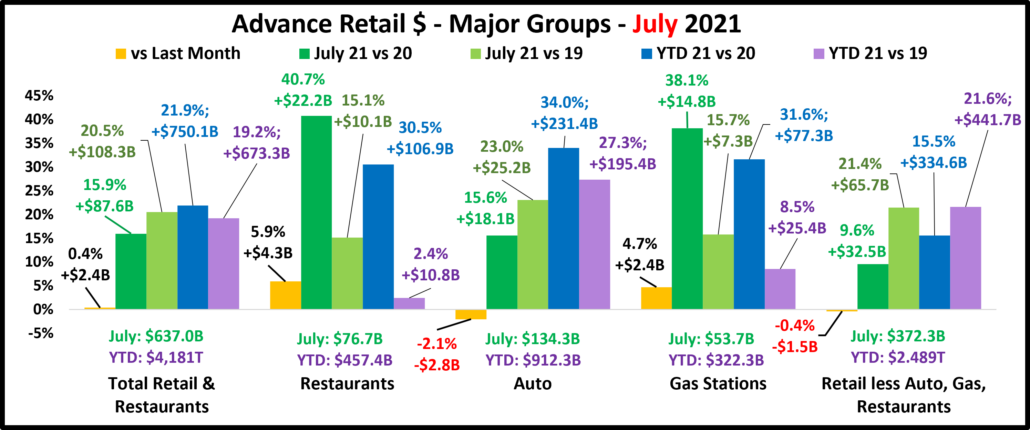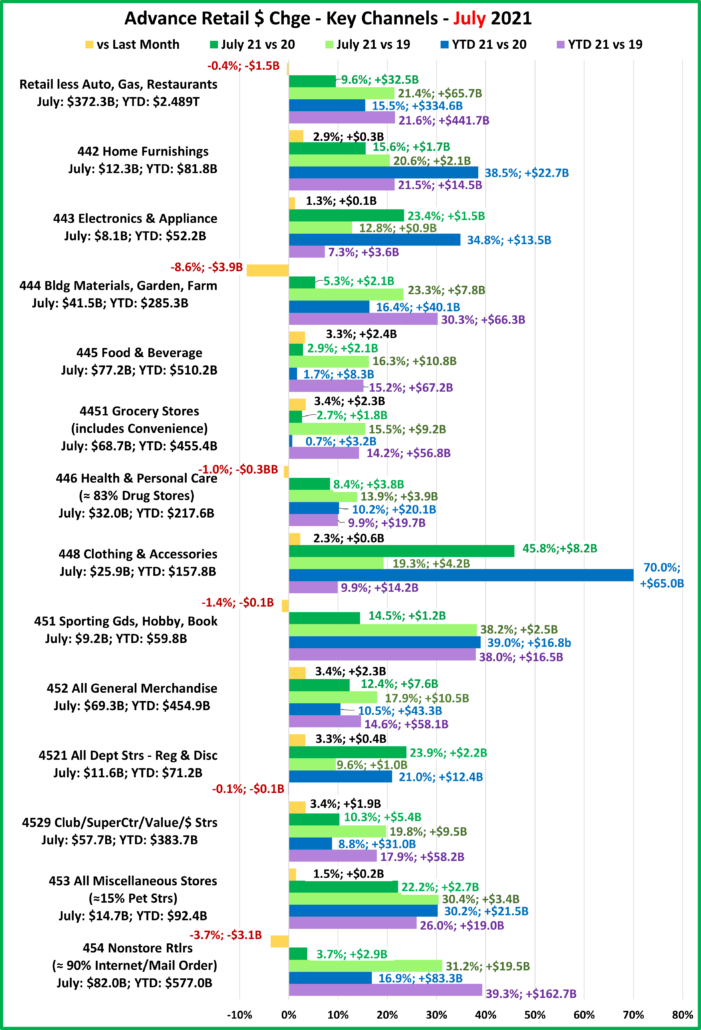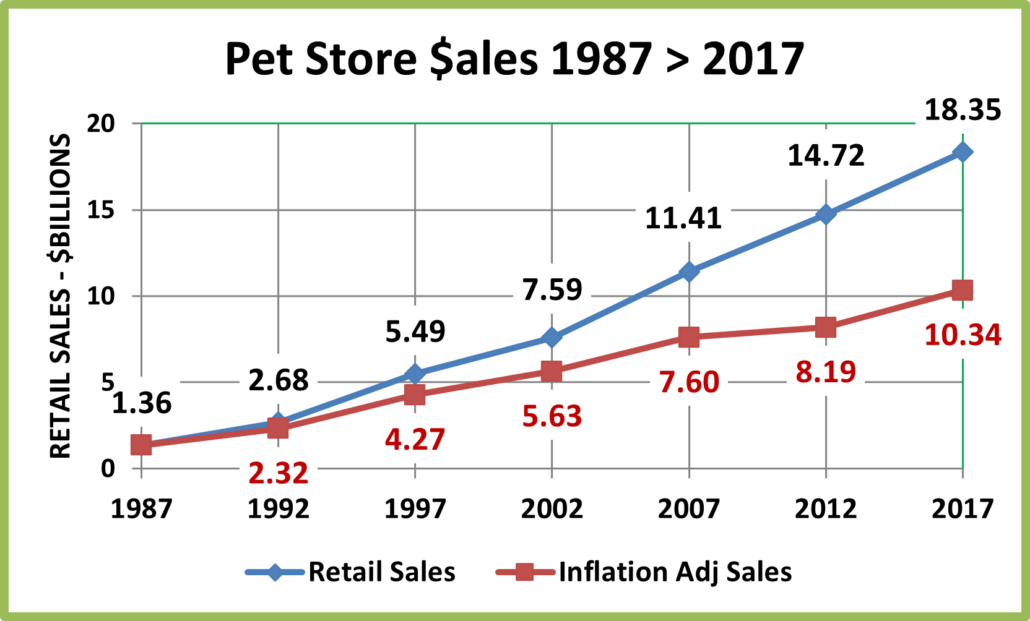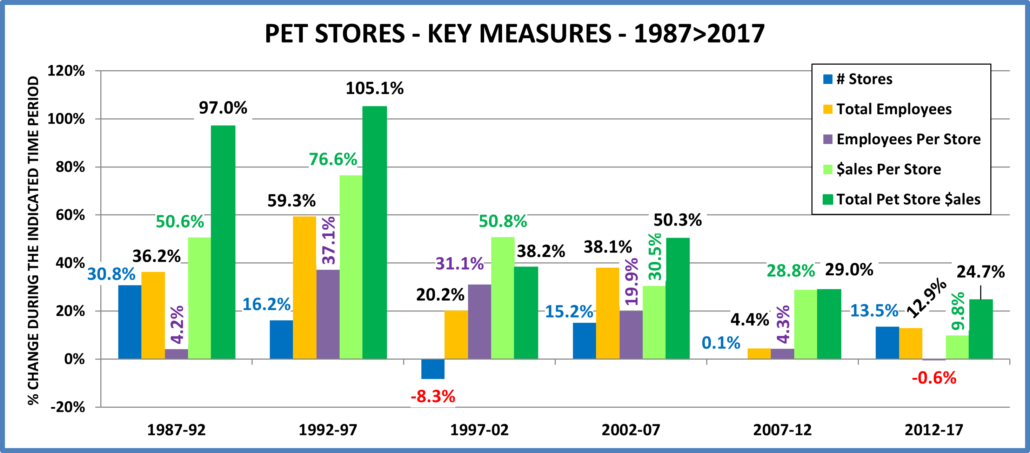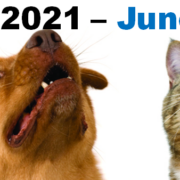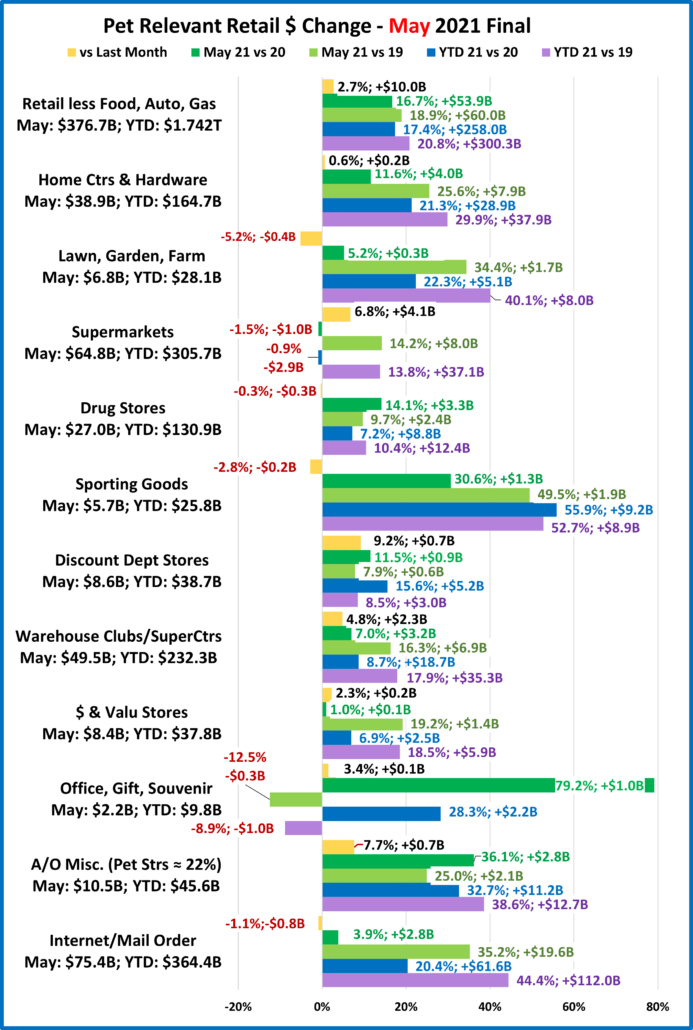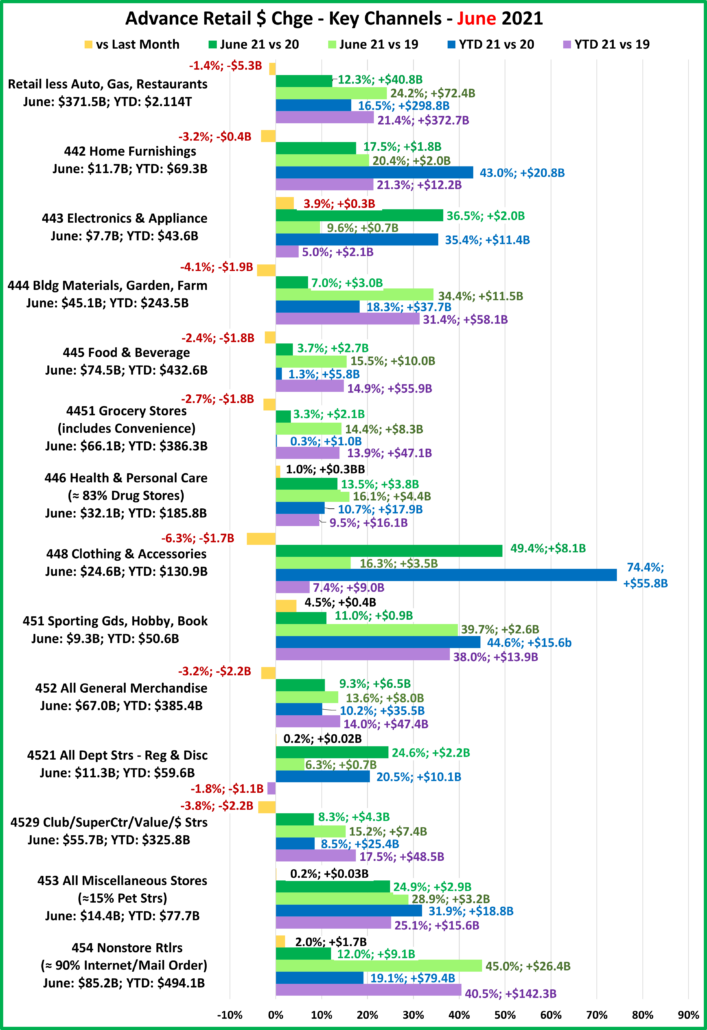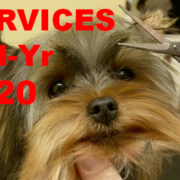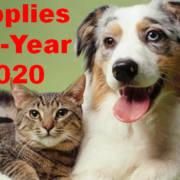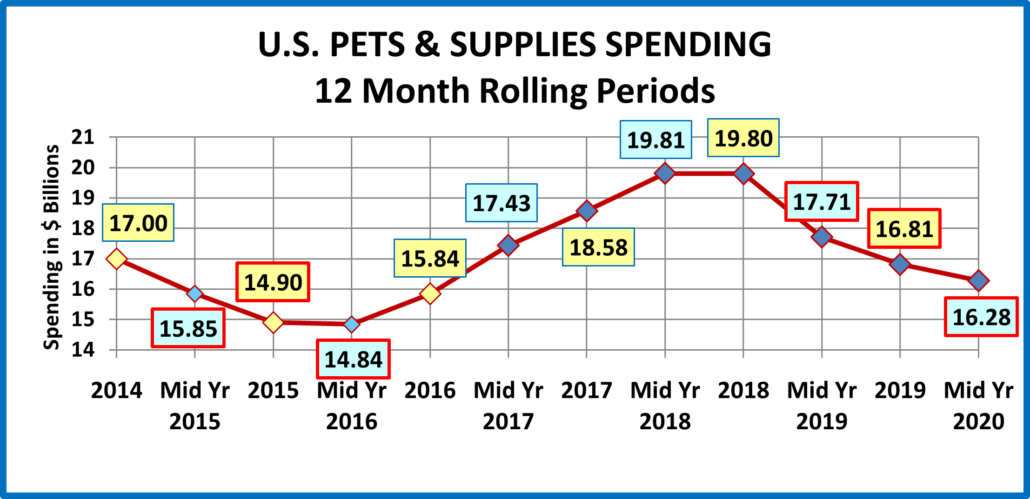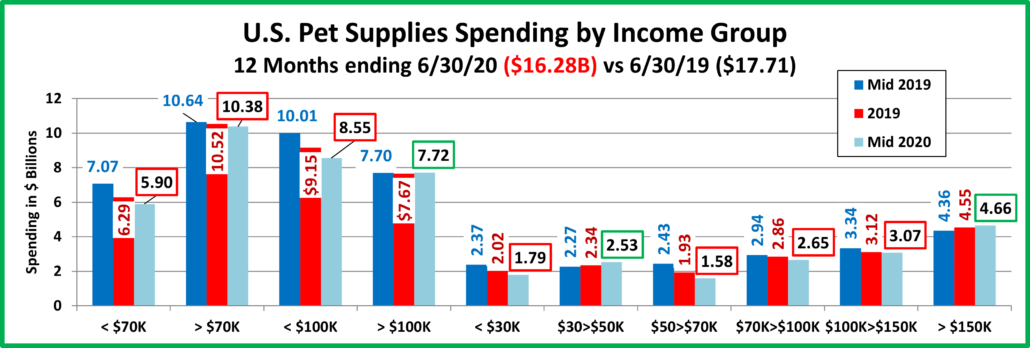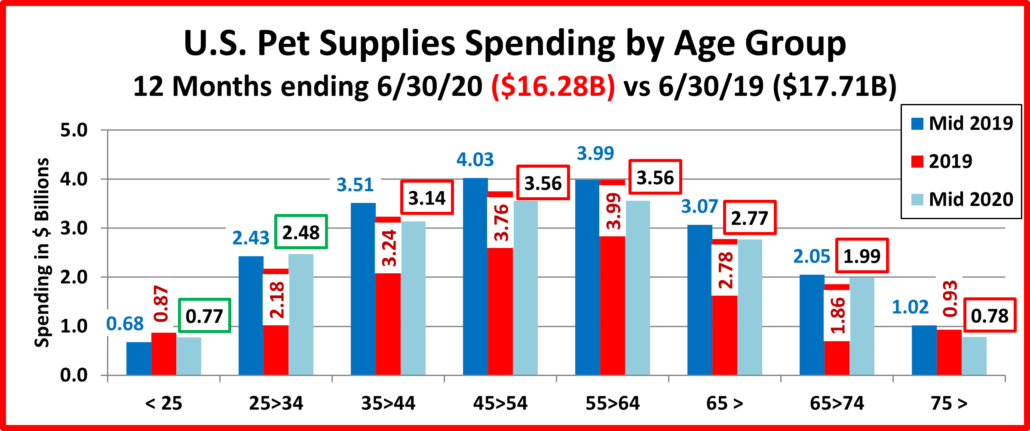Retail Channel Monthly $ Update – August Final & September Advance
In May 2020, the Retail market began its recovery after hitting bottom in April. The road back has been long and complex and Consumer spending behavior continues to evolve. We have not beaten the virus yet so we will continue to track the ongoing recovery of the retail marketplace with data from two reports provided by the U.S. Census Bureau.
The Reports are the Monthly Retail Sales Report and the Advance Retail Sales Report. Both are derived from sales data gathered from retailers across the U.S. and are published monthly at the same time. The Advance Report has a smaller sample size so it can be published quickly – about 2 weeks after month end. The Monthly Final Report includes data from all respondents, so it takes longer to compile the data – about 6 weeks. Although the sample size for the Advance report is smaller, the results over the years have proven it to be statistically accurate with the final monthly reports. The biggest difference is that the full sample in the Final report allows us to “drill” a little deeper into the retail channels.
We will begin with the Final Retail Report for August and then move to the Advance Report for September. Remember, the retail impact of the pandemic began in March 2020, peaked in April, then recovery started in May. We will compare 2021 to both 2020 and 2019 to document the progress that the retail market has made towards a full recovery.
Both reports include the following:
- Total Retail, Restaurants, Auto, Gas Stations and Relevant Retail (removing Restaurants, Auto and Gas)
- Individual Channel Data – This will be more detailed in the “Final” reports and we fill focus on Pet Relevant Channels
The information will be presented in detailed charts to facilitate visual comparison between groups/channels of:
- Current Month change – % & $ vs previous month
- Current Month change – % & $ vs same month in 2020 and 2019
- Current YTD change – % & $ vs 2020 and 2019
- Monthly and Year To Date $ will also be shown for each group/channel
First, the August Final. Retail hit bottom in April 2020 but began recovery, hitting record $ in December. $ fell in January & February but set a new all time $ record in March. In April $ fell but they rebounded in May to another record high. Sales have slowly declined through August. Here are the major retail groups. (All $ are Actual, Not Seasonally Adjusted)
The final total is $2.0B more than the Advance report projected a month ago. All groups were up slightly. The specifics were: Relevant Retail: +$0.7B; Gas Stations: +$0.6B; Auto: +$0.4B: Restaurants: +$0.3B. Sales vs July were down in all but Relevant Retail. Total Retail $ were the 8th highest month of all time. Total $ales broke $600B for the 1st time in December and has now done it 8 times. Auto still has the strongest recovery and is in fact prospering – annual YTD growth rate since 2019 is +11.9%. There were spending dips vs the previous month but for the third consecutive month, all groups were positive in all other measurements.
Now, let’s see how some Key Pet Relevant channels were doing in August.
- Overall– 5 of 11 channels were down vs July but all were up vs August 2020 and 10 vs August 2019. In YTD $, all were up vs 2020 and 10 vs 2019. August was the 4th biggest month in history for Relevant Retail.
- Building Material Stores – Their amazing lift may finally be slowing. The surge came as a result of pandemic spending patterns developed in 2020. Consumers began focusing on their homes. Their Spring lift has slowed in 2021 but Building and Farm stores are still going strong. Sporting Goods stores have a similar spending pattern. Sales took off in May 2020, hit a record peak in December and continued strong into 2021, peaking in March. After slowing in July, the $ increased in August. YTD they are +47.4% vs 2019, an Annual Growth Rate of 21.4%!
- Food & Drug – Supermarkets were +$77.7B in 2020. $ are down vs July but YTD are on par with the 2020 binge. They are up 14% vs August 2019 and 14.3% vs YTD 2019. Drug Stores were +$17B (+5.7%) for 2020. They had a record March. Sales have been stable since then, but all other measurements are positive and YTD $ are +7.6%.
- General Merchandise Stores – $ in all channels fell in Jan & Feb then spiked in March. Monthly sales by channel have been slightly up or down since then but GM has been strong, +14% YTD. $ Stores & Clubs/SuperCtrs are leading the way with a combined growth rate of +8.5%. These channels promote value. Their success reinforces its importance to consumers. Also, Discount Dept Stores are again back in the game.
- Office, Gift & Souvenir Stores– $ increased slightly from July and were +20.5% vs August 2020. The pandemic hit them hard. They are still down vs 2019 – monthly and YTD. Recovery is a long way off, but things are improving.
- Internet/Mail Order – Their $ were up vs July as the pandemic continues to foster this channel’s growth. In August of 2019, their YTD growth was +13.9%. Now, their avg growth rate is +19.6% – a 41.0% increase.
- A/O Miscellaneous – This is a group of small to midsized specialty retailers – chains and independents. It includes Florists, Art Stores and Pet Stores (22>24% of total $). Pet Stores were usually essential, but most stores were not. In May 2020 they began their recovery. Their 2020 total sales were up +11.6%. Their August $ were down slightly from July but still #4 of all time. YTD sales are +27.5% vs 2020 and +39.3% vs 2019. Very strong!
Relevant Retail began recovery in May and reached a record level in December. $ fell in Jan & Feb, turned up again in March and began a monthly up/down rollercoaster. August $ are up and all channels but 1 are ahead of 2019 & 2020. The key drivers are the Internet, SuperCtrs/Clubs/$ Stores and Hdwe/Farm. Now, the Advance numbers for September.
2020 was a memorable year for both its traumas and triumphs. In April & May we experienced the 2 biggest retail spending drops in history, but the problems actually began in March. Retail sales began to recover in June and in October, YTD Total Retail turned positive for the 1st time since February. In December, Total Retail broke the $600B barrier – a historic first. Sales fell from their December peak in both January and February but still set monthly sales records. Then they took off again in March, setting a new monthly sales record of $633B. April sales were down slightly but they took off again in May to set yet another spending record, $643.1B. June>Sept $ fell but September was still the 8th biggest $ month in history. All major groups were down from August, but were positive in all other measurements for the fourth straight month. Some other areas of the economy are still suffering, some spending behavior has changed, and inflation has become a bigger factor in some increases. However, consumers continue to spend “big bucks”, especially in Relevant Retail, and the overall Retail marketplace continues its strong recovery.
Total Retail – In March, Total Retail hit $633.1B, a record for the most spending in any month in any year. In April, $ales dipped to $625.5B but were still $218.3B more than April 2020 – a record increase that was more than double the size of last year’s record drop. In May, sales set another new record, $643.1B. June>Sept sales dipped slightly and September was the 3rd smallest month this year, which is normal. However, at $606.8B, it was still the 8th biggest month in history. Moreover, the current YTD average annual sales growth rate since 2019 is 9.2%, the highest ever in records going back to 1992. Total Retail has not just recovered. It is stronger than ever.
Restaurants – This group has no negative measurements vs 2020 or 2019 for 4 straight months. Last February YTD sales were up 8.1% vs 2019. The Pandemic changed that. Restaurants started to close or cease in person dining in March and sales fell -$33.3B (-52.5%) compared to March 2019. Sales bottomed out in April at $30.1B, the lowest April sales since 2003. Sales started to slowly increase in May but never reached a level higher than 88% compared to the previous year. 2021 started off slowly. Through February, YTD sales were down -16.7% from pre-pandemic 2020 and -10.0% from 2019. In March sales took off and grew steadily from April Through July. Sales dipped slightly in August/September but were still strong vs 2019 & 2020. YTD their $ are plus 30.5% vs 2020 and +4.1% vs 2019. Their recovery is getting stronger.
Auto (Motor Vehicle & Parts Dealers) – Staying home causes your car to be less of a focus in your life. Sales began to fall in March and hit bottom in April. Auto Dealers began combating this “stay at home” attitude with fantastic deals and a lot of advertising. It worked. They finished 2020 up 1% vs 2019 and have returned to a strong positive pattern in 2021. The “attitude” grew amazingly positive in March and slowed only slightly in April>September as sales exceeded $122B in all 7 months – the 7 biggest months in history. To show how well consumers responded to their campaign you just need to look at the data. This group has exceeded $110B in monthly sales only 16 times in history. 13 of those occurred after the onset of the pandemic. YTD Avg Annual Growth Since 2019 = +11.8% – the best performance of any big group.
Gas Stations – Gas Station $ales have been a mixed bag. If you drive less, you visit the gas station less often. Sales turned down in March 2020 and reached their low point in April. They moved up but generally stayed about 15% below 2019 levels for the rest of 2020. In February they were still behind 2020 in monthly and YTD $ but ahead of 2019 in both measurements. In March, sales skyrocketed and continued to grow to to a record $53.5B in July. They fell in Aug/Sept but are still +38% from 2020. They have been positive in all measurements vs 2019 & 2020 since March. Their comeback continues but there is another factor that must be considered – inflation. Gas prices can be pretty volatile. They dipped in the first 2 months of the pandemic but then returned to more normal levels for the balance of 2020. They began strongly inflating in 2021. In fact, September 2021 prices were 42.1% above 2020. That means that the 38.3% year over year $ lift in September was actually a decrease in the amount of gas sold. YTD Annual Growth Rate Since 2019 = +5.2%
Relevant Retail – Less Auto, Gas and Restaurants – This is what we consider the “core” of U.S. retail and has traditionally accounted for about 60% of Total Retail Spending. When you look at the individual channels in this group, you see a variety of results due to many factors – non-essential closures, binge buying, online shopping and a consumer focus on “home”. However, overall, April 2020 was the only month in which spending in this group was down vs 2019. Monthly $ales exceeded $400B for the first time ever in December ($407B). They finished 2020 up $260B, +7.1%. Their performance was the only reason that Total Retail was able to finish 2020 with positive numbers, +0.5%. Sales fell in January and February but set monthly records. In March they turned sharply up and then down in April. They bounced back in May then fell in June & July. In August sales rose again but fell in September. However, we should note that while December 2020 is still #1, March > September are 7 of the 9 highest $ months of all time. The Relevant Retail Market has exceeded $361B in monthly sales 9 tImes in history. 7 of those have occurred since the onset of the pandemic. It is also very important that the Relevant Retail group has posted positive numbers versus last year and YTD for every month since April 2020 and their average YTD growth rate since 2019 now stands at +10.4%. The recovery has become widespread as all channels have been positive in all measurements vs both 2020 and 2019 for 2 consecutive months. However, the primary drivers throughout the pandemic were and continue to be Nonstore, Grocery, SuperCenters/Clubs/$ Stores plus an exceptionally long 2020 “spring lift” from Hardware/Farm and Sporting Goods.
Now let’s look at what is happening in the individual retail channels to see where the $ are coming from. September $ were down 3.6% from August and the drop was widespread. However, a dip in September $ is normal and at -3.6% it was less than half of the -8% drop in 2019. The groups in the chart are less defined than in the Final Monthly reports and we will look across the whole market, not just pet relevant outlets.
Sales in 12 of 13 channels were down vs August but all were up vs September 2020, vs September 2019 and YTD vs 2020 and 2019. (Relevant Retail YTD Avg Annual Growth Rate since 2019 = +10.4%)
After hitting bottom in April 2020, Relevant Retail has now beaten the previous year’s $ for 17 consecutive months. The group set an all-time record of $407B in December and finished 2020 +$260B vs 2019. 2021 started strong, with record sales in every month. March > Sept. were 7 of the 9 biggest of all time. Essential channels are still the primary drivers:
- Nonstore Retailers – The biggest driver. Online shopping continues to grow in # of households and in $.
- Food & Beverage – Grocery– Restaurant $ are improving but consumers continue to eat & drink more at home.
- Bldg Materials/Garden/Farm– Their “Spring” lift may be ending but consumers are still focused on their homes.
- SuperCtrs/Club/Value/$ Strs – They kept the GM channel strongly positive. Value is still a big consumer priority.
Regarding the Individual Large Channels (Includes YTD Avg Annual Growth Rate since 2019)
General Merchandise Stores – Sales fell for all channels in September, but all other numbers were positive. Even Department Stores $ are growing increasingly positive. After dipping to +7.5% in February, the growth rate by Club/SuperCtr/$ stores has remained near the current 8.8%. These stores are still the key to this channel.
- YTD Avg Annual Growth: All GM = +7.4%; Dept Stores = +1.2%; Club/SuprCtr/$ = +8.8%
Food and Beverage, plus Health & Personal Care Stores – Sales in Grocery were down in March>May from 2020 – No surprise, as these were 2020 binge months. In June>Sept they beat 2020 $. The Health, Personal Care group finished 2020 at +1.8% but 2021 has been better. September was down from August but YTD they are +10% vs 2020 and 2019.
- YTD Avg Annual Growth: Grocery = +7.2%; Health/Drug Stores = +5.2%
Clothing and Accessories; Electronic & Appliances; Home Furnishings – March > Sept have been spectacular for all these channels. The increase in Clothing vs September 2020 was less than usual but was still +22.5%. Only Furniture was up vs August, but all remained positive in all measurements vs 2020 or 2019 for the 7th consecutive month.
- YTD Avg Annual Growth: Clothing = +5.1%; Electronic/Appliance = +3.4%; Furniture = +10.3%
Building Material, Farm & Garden & Hardware – Their “Spring” lift which began in 2020 may be slowing. They have greatly benefited from consumers focusing on their home needs. They finished 2020 +53B (+13.8%). Sales took off in March, set a record in April then trended down May > Sept. They are still +14.4% YTD. Avg Annual Growth = +13.8%
Sporting Goods, Hobby and Book Stores – Book & Hobby stores are open but Sporting Goods stores have driven the lift in this group. Consumers turned their attention to personal recreation and sales in Sporting Goods outlets took off. The group ended 2020 +5.5% vs 2019. The growth accelerated in 2021. Even though $ fell 10% in September, it was still good enough for the 9th consecutive monthly record. September YTD they are +32.9% vs 2020. Avg Annual Growth = +17.1%
All Miscellaneous Stores – Pet Stores were deemed essential but most other stores were not, so closures hit this group particularly hard. Sales hit bottom at -$3.8B in April then began to rebound. They finished with a strong December and ended 2020 -$1.0B, -0.7%. In March 2021 sales took off and reached the $14+B level in May and they have stayed there. Sales fell -2.9% in September, but their YTD sales are now 27.8% above 2020 and 26.0% more than 2019. Their recovery has become very real. YTD Avg Annual Growth = +12.3% (4th Best)
NonStore Retailers – 90% of the volume of this group comes from Internet/Mail Order/TV. The pandemic accelerated the movement to online retail. In February 2020 NonStore $ were +8.6% YTD. In December monthly sales exceeded $100B for the 1st time. They ended 2020 at +21.4%, +$162.9B. This was 63% of the total $ increase for Relevant Retail Channels. Their 2020 performance far exceeded their 12.9% increase in 2019 and every month in 2021 has produced record $. September was -2.5% vs August but +10.6% vs 2020. YTD $ are +15.2%. YTD Avg Annual Growth = +17.9%
Note: Almost without exception, online sales by brick ‘n mortar retailers are recorded with their regular store sales.
Recap – 2020 was quite a year. April & May had the 2 biggest year over year sales decreases in history while December sales broke $600B for the first time. 2021 may become even more memorable. March>September are 7 of the 8 biggest $ales months in history with the 7 largest year over year monthly sales increases ever. The total increase was +$861B, which is 5 times the -$174B decrease from March>May 2020 which caused so much concern. At yearend 2020, Restaurants and Gas Stations were still struggling but Auto had largely recovered. Relevant retail had segments that also struggled but they still led the way for Total Spending to finish the year +0.5% vs 2019. 2021 has been even better. In June > September all major groups are positive vs both 2020 and 2019. The recovery has also become real for virtually all channels and monthly sales continue to set records. In fact, the current annual growth rates of +9.2% for Total retail and +10.4% for Relevant Retail are the highest in history. Retail has recovered but we’ll keep checking.

